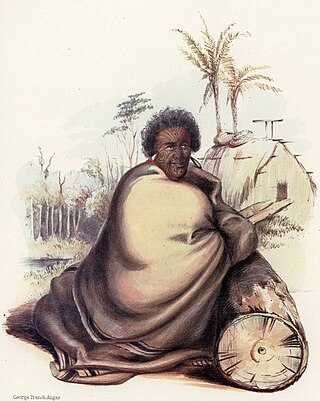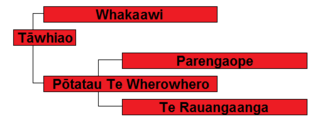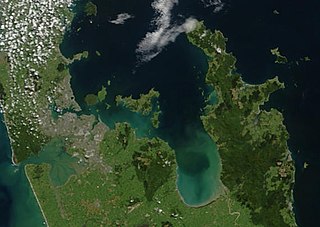
KīngiTāwhiao, known initially as Matutaera, reigned as the Māori King from 1860 until his death. After his flight to the King Country, Tāwhiao was also Paramount Chief of the Rohe Pōtae for 17 years, until 1881. A Waikato Tainui nobleman, rangatira, and religious figure, Tāwhiao amassed power and authority during a time of momentous change, to become de facto leader of the Waikato tribes. He was a member of the Ngati Mahuta hapū, who comprise the kāhui ariki.

Dame Te Atairangikaahu was the Māori queen for 40 years, the longest reign of any Māori monarch. Her full name and title was Te Arikinui Dame Te Atairangikaahu. Her title Te Arikinui and name Te Atairangikaahu were bestowed when she became monarch; previously she was known as Princess Piki Mahuta and, after marriage, Princess Piki Paki. Her full whakapapa (lineage) name, linking her to previous Māori monarchs, was Te Atairangikaahu Korokī Te Rata Mahuta Tāwhiao Pōtatau Te Wherowhero.

The Māori King Movement, called the Kīngitanga in Māori, is a Māori movement that arose among some of the Māori iwi (tribes) of New Zealand in the central North Island in the 1850s, to establish a role similar in status to that of the monarch of the British colonists, as a way of halting the alienation of Māori land. The Māori monarch operates in a non-constitutional capacity without explicit legal or judicial power within the New Zealand government. Reigning monarchs retain the position of paramount chief of several iwi, and wield some power over these, especially within Tainui. The influence of the Māori monarch is widespread in Māoridom despite the movement not being adhered to by several major iwi, notably Tuhoe, Ngāti Porou, and the largest of all, Ngāpuhi.

Pōtatau Te Wherowhero was a Māori rangatira who reigned as the inaugural Māori King from 1858 until his death. A powerful nobleman and a leader of the Waikato iwi of the Tainui confederation, he was the founder of the Te Wherowhero royal dynasty. His 1858 ascension followed years of efforts to create the Kīngitanga, a Māori monarchy intended as an equivalent of the British monarchy, and to foster Māori nationalism against settler encroachment.
Waikato Tainui, Waikato or Tainui is a group of Māori iwi based in Waikato Region, in the western central region of New Zealand's North Island. It is part of the larger Tainui confederation of Polynesian settlers who arrived to New Zealand on the Tainui waka. The tribe is named after the Waikato River, which plays a large part in its history and culture.

Korokī Te Rata Mahuta Tāwhiao Pōtatau Te Wherowhero was the fifth Māori King. He was the elder son of the fourth Māori King, Te Rata Mahuta, and Te Uranga Matai of the Ngāti Korokī tribe.

Te Rauangaanga was the chief of the Ngāti Mahuta tribe of the Waikato tribal confederation and the principal war chief of the confederation in the late 18th and early 19th centuries. His son Pōtatau Te Wherowhero became the first Maori king.

Parengaope was a female Māori high chieftain of Ngāti Koura, a hapū (subtribe) of the Waikato tribal confederation. She was the wife of Te Rauangaanga and mother of Pōtatau Te Wherowhero, the first Māori king, and grandmother of King Tāwhiao.
Ngāti Mahuta is a sub-tribe of the Waikato tribe of Māori in the North Island of New Zealand. The territory (rohe) of Ngāti Mahuta is the Kawhia and Huntly areas of the Waikato region.
There are at least four different people called Te Kanawa.

Tūheitia Pōtatau Te Wherowhero VII, crowned as Kīngi Tūheitia, reigned as the Māori King from 2006 until his death in 2024. He was the eldest son of the previous Māori monarch, Te Arikinui Dame Te Atairangikaahu, and was announced as her successor and crowned on 21 August 2006, the final day of her tangi.

Taupiri is a small town of about 500 people on the eastern bank of the Waikato River in the Waikato District of New Zealand. It is overlooked by Taupiri mountain, the sacred burial ground for the Waikato tribes of the Māori people, located just to the north.

Ngāti Pāoa is a Māori iwi (tribe) that has extensive links to the Hauraki and Waikato tribes of New Zealand. Its traditional lands stretch from the western side of the Hauraki Plains to Auckland. They also settled on Hauraki Gulf islands such as Waiheke.

The Battle of Hingakākā was fought between two Māori armies of the North Island, near Te Awamutu and Ōhaupō in the Waikato in the late 18th or early 19th century, and was reputedly "the largest battle ever fought on New Zealand soil". One army was from the south of the North Island and the other from the Tainui confederation of the central North Island. Both armies included allied forces from several different hapū and iwi.
Whatumoana Paki was a New Zealand Māori royal elder. Paki was the husband of the Māori Queen, Te Atairangikaahu, who reigned from 1966 to 2006. He and Te Atairangikaahu were the parents of the seventh Māori monarch, Tūheitia Paki.
Piupiu Te Wherowhero was a female leader within the Māori royal family in early 20th century New Zealand.

Pei Te Hurinui Jones was a Māori political leader, writer, genealogist, and historian. As a leader of the Tainui tribal confederation and of the Māori King Movement, he participated in negotiations with the New Zealand Government, seeking compensation for land seizures, served on several boards, and authored a number of works in Māori and English, including the first history of the Tainui people.
Ngāti Te Wehi is a Māori iwi (tribe) based in Kawhia on the west coast of New Zealand's North Island.
Pāoa ('smoke') was a Māori rangatira (chieftain) of the Tainui tribal confederation from the Waikato region, New Zealand. He is the ancestor of the Ngāti Pāoa iwi. He probably lived in the first half of the seventeenth century.

Ngā Wai Hono i te Pō is the Queen of the Māori King movement. She was raised to the throne on 5 September 2024, being elected to succeed her father Kīngi Tūheitia. Her full name and title is Te Arikinui Kuīni Ngā Wai Hono i te Pō. Her titles Te Arikinui and Kuīni were bestowed when she became monarch. The youngest child and only daughter of Tūheitia, she is a direct descendant of the first Māori King, Pōtatau Te Wherowhero, who was installed in 1858. She is the eighth monarch of the Kīngitanga.












